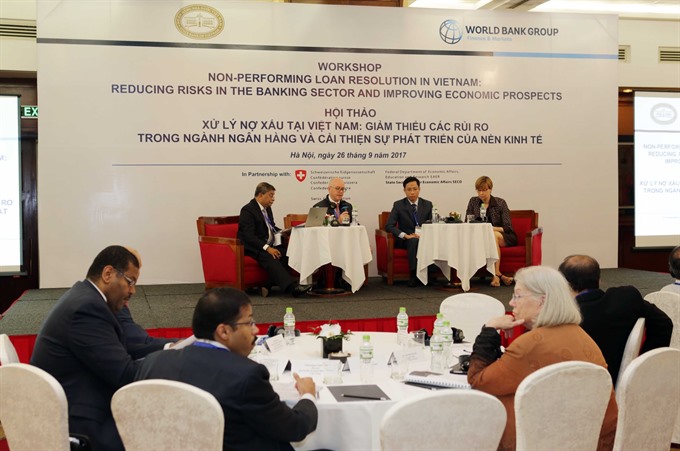 Economy
Economy

Nonperforming loans (NPLs) must be revolved at the earliest, especially in the banking and financial sector, in order to strengthen Việt Nam’s economy, ensure efficiency and boost effectiveness in capital allocation, a World Bank Group (WBG) official told a seminar yesterday.
 |
| Participants exchange experiences in recognising, managing, and resolving NPLs across the globe. — VNA/VNS Photo |
HÀ NỘI — Nonperforming loans (NPLs) must be revolved at the earliest, especially in the banking and financial sector, in order to strengthen Việt Nam’s economy, ensure efficiency and boost effectiveness in capital allocation, a World Bank Group (WBG) official told a seminar yesterday.
Speaking at a workshop on Việt Nam’s bad debts, Nguyễn Phi Lân, Acting Deputy Director General of the Department for Banking System Safety Supervision under the State Bank of Vietnam (SBV), stated that on the whole, most bad debts had been resolved and its current ratio stood at 2.55 per cent of outstanding loans.
According to Lân, since 2012, a systematic restructuring of credit institutions ordered by the Prime Minister was followed by the formation of the Vietnam Asset Management Company (VAMC) in 2013 to help acquire and resolve NPLs. These moves were followed by various legal and regulatory amendments designed to tackle NPLs and help stabilise the economy.
These courses of action have proved effectual, with the VAMC actively assisting credit institutions in handling NPLs using special bond provisioning, enterprise restructuring, risks reduction and credit growth promotion.
Đoàn Văn Thắng, Chief Executive Officer of the VAMC, listed a number of approaches to NPL resolution that his company had employed to some extent of success, in which the SBV and the Government assign the VAMC to repurchase NPLs from credit institutions at fair market value paid in cash or bonds, effectively removing the NPLs from the credit institutions’ rolls.
Below 3 per cent
As such, the model is not only suitable to Việt Nam’s economic conditions, but also successful in keeping the banking sector’s bad debts below 3 per cent by 2020, according to Thắng. This should help credit institutions and commercial banks remove NPLs from their balance sheets, and reduce risk provision pressure while increasing credit worthiness.
Since its formation, the VAMC has successfully purchased up to 26,110 NPLs from 16,197 institutions using special bonds. Most notably, in 2017, the VAMC managed to repossess the Saigon One Tower in HCM City from a number of customers whose total outstanding debts had accumulated to more than US$311.8 million.
Jennifer Isern, WBG’s Finance and Markets Practice Manager for East Asia and the Pacific, said the Vietnamese Government and the SBV had made positive progress in tackling NPLs.
Nevertheless, Isern warned that total outstanding and potential NPL volume remained high, with risks to the country’s financial institutions. She also said she believed the regulatory framework on handling NPLs and securing collateral remained somewhat ineffective, and that successful management of NPLs in Việt Nam would be essential, as would be strengthening lending practices and financial sector oversight to prevent an accumulation of NPLs.
Furthermore, she regards banking sector reform as fundamentally important for Việt Nam to maintain the systematic capacity of the economy.
Katia D’Hulster, the WBG’s Lead Financial Sector Specialist in Finance and Markets, said the SBV must impose a strict supervisory regime on NPL resolution, in which commercial banks should be supervised and assisted by the SBV throughout the process of NPLs governance, operation, recognition and impairment, as well as forebearance and collateral valuation specification.
In particular, yesterday’s workshop focussed on the recently approved Resolution 42, aiming to improve the regulatory framework on NPLs and secure collateral resolution, as well as developing the NPL market by addressing the issues of eligible debt buyers and land titles.
Potential risks
According to the SBV, the regulation pathway set by the National Assembly to restructure the credit system is raising some concerns regarding NPLs resolution.
A key issue is the increasing value of NPLs and potential bad debts, which pose potential risks to the economy’s safety and efficiency. This could be due to difficulties in dealing with collateral foreclosure, and the lack of synchronisation in implementing the legal framework set by the Government, which still relies on the banking sector for funding and measures instead of the State budget.
As such, on behalf of the VAMC, Thắng suggested some improvements in the country’s NPL resolution legal framework, providing the VAMC with up to $89 million budget, as well as establishing an inter agency committee for debt resolution, and developing the market for buying and selling NPLs.
The workshop was jointly held by the WBG and the SBV, with support from the Swiss State Secretariat for Economic Affairs, with more than 100 policy makers, economic experts, and private sector representatives gathered to exchange experiences in recognising, managing, and resolving NPLs across the globe. — VNS